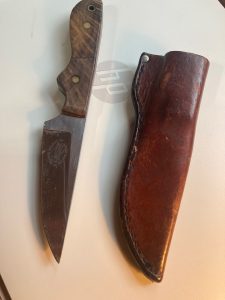Best Hunting Knives

By V. Paul Reynolds
Over the years, an assortment of different hunting knives have wound up in my hunting day pack. Some have worked better than others. Some held an edge well; and some did not. Without a doubt, the litmus test I have encountered with a hunting knife is when the knife is used to skin an elk during the so-called “dry dressing method.” Nothing will dull a knife faster than the coarse hairs of an elk hide. A moose hide would present the same cutting challenge.
After some knife-dulling frustration with my first dry- dressed elk, my second elk hunt found me better prepared. My day pack included not one, but two conventional hunting knives, a hand sharpener and a razor sharp utility knife with a box of extra blades.
What do you carry for a hunting knife?
Bearing in mind that choices of hunting knives abound, and in an attempt to narrow the focus some, the aforementioned question was put to some Maine hunting guides and others who depend upon a skinning or quartering knife a great deal more often than the average deer hunter.
The List
Here is a quick summary of our informal survey:
1. Warden Kale O’Leary. A Havalon knife
2. Aroostook Hunter Mike Maynard. A Boker, a German knife handed down by his father.
3. Maine guide and outfitter John Floyd. A Benchmade Steep knife
4. North Maine Woods director Bill Greaves. A Buck knife.
5. Maine big buck hunter Hal Blood. A Buck 102 knife.
6. Wild Chef and outdoorsman Denny Corriveau. Outdoor Edge Knife
7. Guide Matt LaRoche. Schrade 4” blade folding knife.
8. Vermont outdoorsman Gary Moore. A knife made by Vermont’s Kingdom Knives
9. Downeast guide Randy Spencer. K-bar for field dressing and a Rapala Finlander for fish.
10. Maine moose biologist Lee Kantar. Outdoor Edge drop point knife. 3.5 “ swing blade.
11. Aroostook County Moose guide Dave Hentosh. Case knife with a 5” blade.
For what it’s worth, the consensus from national knife “experts” is that in order of priority these are the hunting knives that belong at the top of the heap:
Benchmade Steep Country (Model 15006 or 15060)
-
Blade: 3.5–4 inches, CPM-S30V steel
-
Pros: Grippy handle, ultra-sharp, durable edge, great balance
-
Why it’s great: Designed specifically for big game. Tough enough for quartering, nimble enough for skinning.
Knives of Alaska Bush Camp Combo (with Cub Bear caping knife)
-
Blade Steel: D2 tool steel
-
Pros: The Bush Camp knife handles heavy work (joints, pelvis), and the Cub Bear is perfect for delicate skinning
-
Why it’s great: A durable, field-proven set ideal for moose and elk-sized game.
-
Outdoor Edge RazorPro or Havalon Talon/Havalon Piranta Edge
-
Pros: Always-razor-sharp, easy to swap blades, light to carry
-
Cons: Blades can snap if you try to pry joints—don’t use for quartering
-
Why it’s great: For precision skinning and boning, nothing is sharper.
As far as costs go, the first choice, the Benchmade hunting knife, retails in the $200.00 range. The second choice, the Alaskan Bush Knife, retails for about $150.00. The Outdoor Edge or Havalon Talon, which were the only brands to get a double mention in the survey, are less expensive and are in the $50.00 range.
Razor Edge
Whatever the knife, getting a razor edge is the name of the game. Fishing guide Randy Spencer always finishes off his blade work with a leather strop, and swears by it. Moose biologist and avid deer hunter Lee Kantar likes a knife with a so-called drop point, which is a blade design that is excellent when removing a hide or caping. The design reduces the chance of going astray and opening up a critter’s viscera when dry dressing.
If you have a favorite hunting knife that didn’t make the survey, I’d like to hear from you. My email address is [email protected].
For more articles about hunting, fishing, and the great outdoors, be sure to subscribe to the Northwoods Sporting Journal.
